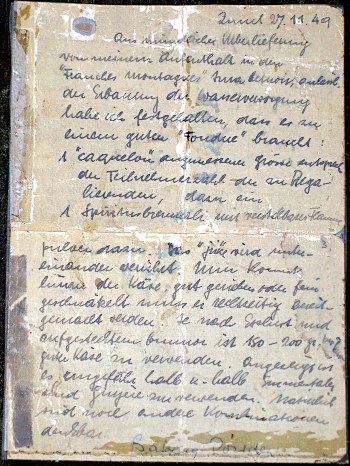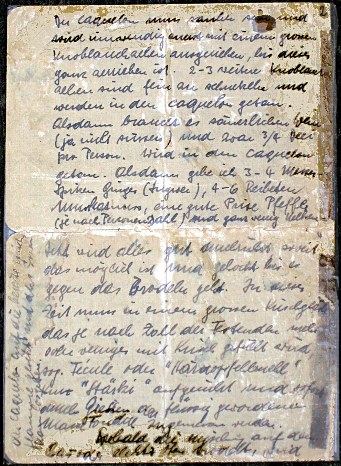Fondue Recipe History
My grandfather Hermann Wipf, a civil engineer, spent some years (late 1930's–early 1940's) in Saignelégier, in the Franches-Montagnes district of what is today the Swiss canton Jura, planning and implementing the construction of the regional water facility. He spent many an evening enjoying a fondue with his local colleagues and learned how to make a good one.
In 1949 he wrote a letter to my mother, now living in America, with the original recipe that my family has since then taken for granted as the way a fondue should taste. Years later I was surprised to discover that the typical fondue, even in Swiss restaurants, is nowhere near this good, and that this recipe is, in fact, a treasured heirloom.
Overseas postage in those days was expensive; the four-page letter is written on both sides of two small sheets of very thin "air-mail" paper, here photographed front and back:
I have transcribed his handwriting to the best of my ability, with some help from my mother; here it is in the original German:
|
Zürich 27.11.49 Aus mündlicher Ueberlieferung von meinem Aufenthalt in den "Franches montagnes" Jura Bergen, anlässl. der Erbauung der Wasserversorgung habe ich festgehalten, dass es zu einem guten "Fondue" braucht: 1 "caquelon" angemessener Grösse entsprechend der Teilnehmerzahl der zu Regalierenden, dazu ein |
2 Der caquelon muss sauber sein und wird innwendig zuerst mit einem grossen Knoblauchzehen ausgerieben, bis dieser ganz zerrieben ist. 2-3 weitere Knoblauchzehen sind fein zu schnetzeln und werden in den caquelon getan. Alsdann braucht es säuerlichen Wein (ja nicht süssen) und zwar 3/4 Deci pro Person. Wird in den caquelon getan. Alsdann gebe ich 3-4 Messerspitzen Ginger (Ingwer), 4-6 Reibeten Muskatnuss, eine gute Prise Pfeffer (je nach Personenzahl) und ganz wenig Nelken- |
|
3 pulver dazu. Das "juice" wird untereinander verrührt. Nun kommt hinzu der Käse, gut gerieben oder fein geschnätzelt muss er rechtzeitig bereitgemacht werden. Je nach Esslust und aufgestelltem Humor ist 150-200 gr. pro Person guter Käse zu verwenden. Angezeigt ist es ungefähr halb u. halb Emmentaler und Gruyère zu verwenden. Natürlich sind noch andere Kombinationen denkbar. |
4 Jetzt wird alles gut durchrührt soweit das möglich ist und gekocht bis es gegen das Brodeln geht. In dieser Zeit muss in einem grossen Kirschgläsli das je nach Zahl der Festenden mehr oder weniger mit Kirsch gefüllt wird, sog. Fécule oder "Härdöpfelmehl" kurz "Stärki" aufgerührt und sofort durch Giessen der flüssig gewordenen Masse Fondue zugemessen werden. Sobald die Mischung auf dem gas- od. elektr. Ofen brodelt, wird der caquelon auf die bereits ignierte Flamme gesetzt und das Essen kann losgehen. |
I've translated this to English, though I fear it loses some of its charm:
|
Zürich 27.11.49 From oral tradition during my stay in the "Franches montagnes" Jura mountains, on the occasion of building the water supply facility, I apprehended that a good "fondue" calls for: 1 "caquelon" of a size appropriate to the number of participants to be regaled, along with |
2 The caquelon must be clean and is first rubbed all over the inside with a large garlic clove until the latter is all rubbed away. 2-3 additional garlic cloves are to be finely minced and put in the caquelon. Then it needs dry, tart wine (not sweet!), 3/4 dL per person. Gets put in the caquelon. Then I add 3-4 knifepoints ginger, 4-6 grates nutmeg, a good pinch pepper (according to number of persons) and a very little clove- |
|
3 powder. This "juice" gets stirred. Now comes the cheese, well-grated or finely shredded, prepared ahead of time. Depending on appetite and convivial humor, 150-200 g. of good cheese is needed per person. It's advisable to use about half-and-half Emmentaler and Gruyère. Naturally other combinations are possible. |
4 Now everything gets mixed as well as possible and cooked to the point of seething. At the same time, in a large Kirsch glass filled with more or less Kirsch according to the number of diners, so-called Fécule or potato flour, that is, "starch" gets stirred up and immediately poured into the now-liquid fondue mixture. When the mixture on the gas- or electric stove comes to a boil, the caquelon is placed on the already-ignited flame and the eating can commence. |
That all seems quite clear, except for a little mystery. My grandfather's Jurassic friends made a point of saying, and he duly recorded, "The caquelon must be clean." Why? Can't we just assume that we start with a clean vessel? Might a caquelon serve in some other purpose that could raise concerns about cleanliness?
Enjoy this excellent fondue (of the Neuchâteloise variety). Share it with family and good friends with good bread, dry wine and real Kirsch, and raise a glass to the memory of Hermann Wipf. Just be sure to use a clean caquelon!

